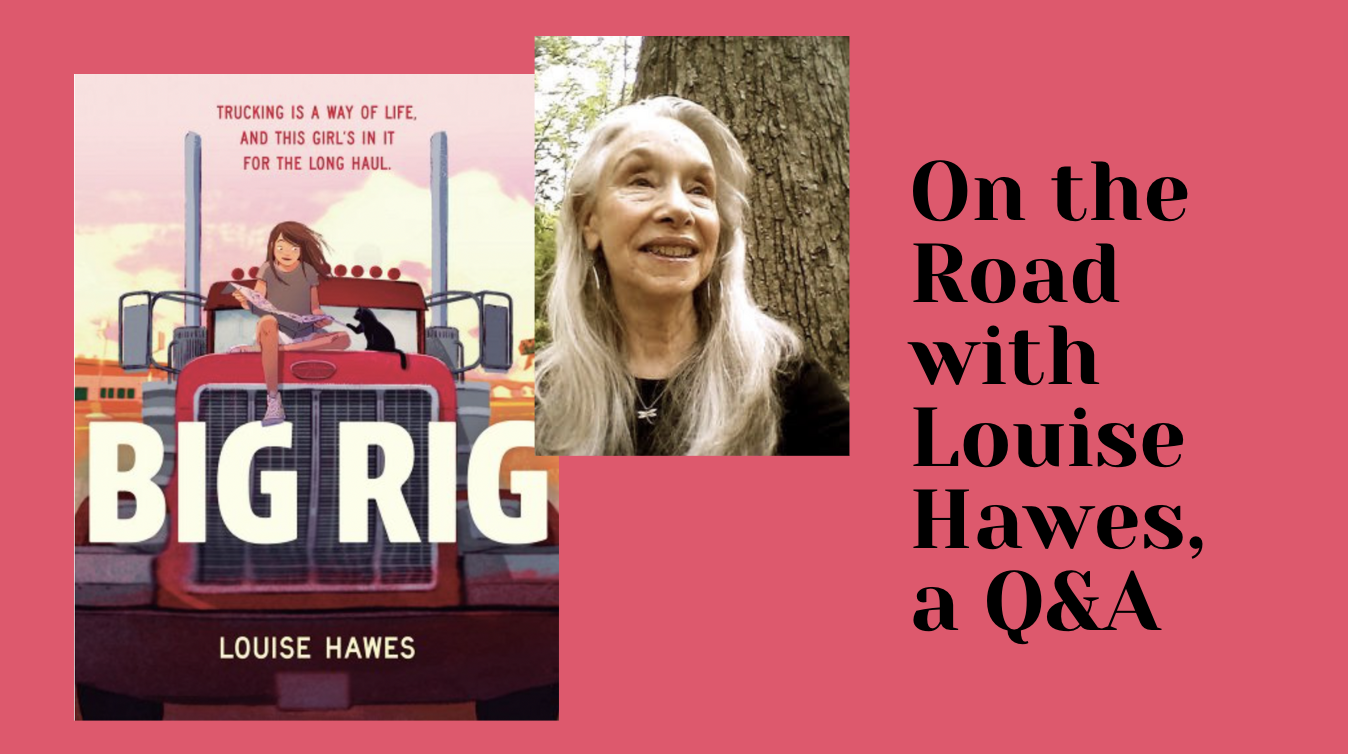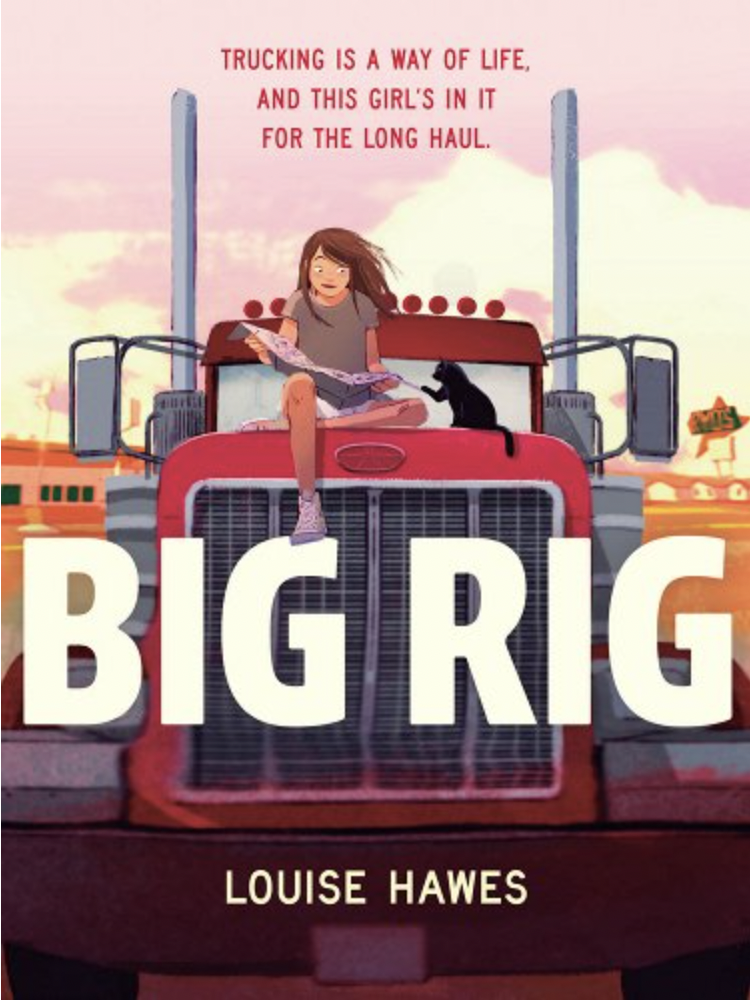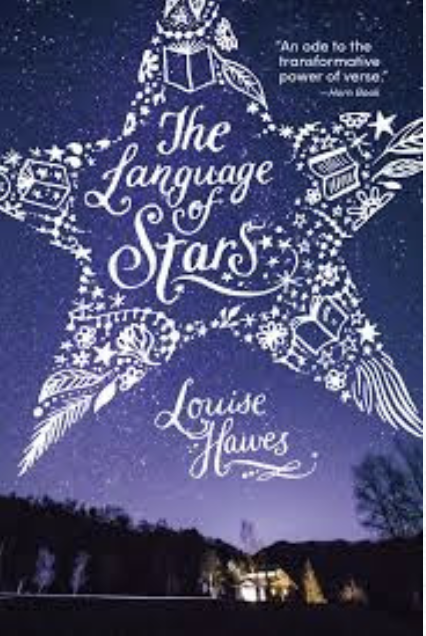I first heard Louise Hawes read from Big Rig at a Vermont College of Fine Arts, Writing for Children and Young Adults Program residency. I immediately fell in love with protagonist Hazel’s big-hearted approach to the world and to the people she meets. She is as big hearted as Louise is herself. In workshops, Louise is always looking for heart moments, where we see beyond the surface of a character. Hazel’s story has plenty. I’m so grateful Louise stopped by to answer all our questions–about Big Rig, her writing process, why countering ageism in children’s lit is important to her, and how her writing has grown by being in community with other writers. Read on to soak up Louise’s wisdom. –Anne-Marie
KidLit Craft: I fell in love with Hazel/Hazmat and her world during your faculty readings at VCFA, and I’m so excited to get to know more of her now that I have a copy of Big Rig in my hands. How did Hazel come to be?
Louise Hawes: A plot or story idea seldom seeds a book for me. What comes to mind and then nests in my heart, is almost always a character. Hazel (aka Hazmat) is no exception. However, she had to be a lot more determined than most folks who end up in my books. I did not welcome the idea of a main character involved in trucking—I didn’t know the first thing about trucks, and I wasn’t interested in learning it, thanks anyway. “But she persisted,” and three years later, I’d done enough research (and enough free writing with Hazmat) to start the novel. As to why or how she first popped into my head, I’m betting it was a combination of stumbling on an internet story about automated, driverless trucks and my own experience with a traveling dad. A dad who traveled the world, and never took his family with him. This novel, I realized only after I’d finished it, was my chance to go with him, to get to know him better than I ever did IRL. These things are always a mystery, though, so that’s just a guess!
KLC: You mention in your acknowledgements that you did some on-the-road research. It paid off! The world of truckers and trucking is so rich in your novel. How did you manage to hitch a ride? What other research did you do for this book?
LH: Drivers themselves were my best source of information. I interviewed dozens of drivers, both “on the road” at truckstops and overlooks, and found dozens more, thanks to their websites and Youtube channels. But, as any writer who’s been swallowed up by a “need to know” about their story’s world can tell you, there’s also a kind of magic that’s set in motion when you let the universe know what you’re looking for. Suddenly, I began to meet drivers and trucking execs totally by chance—sitting next to me on airplane trips, at gatherings with friends, at line in the grocery store—magic! In addition to these “interviews,” I reached out to organizations like Trucker Buddies, who pair individual drivers with middle-grade classrooms; and Women in Trucking, who work with groups like the Girl Scouts to make sure kids and adults know there are varied and crucial roles for women in the trucking industry.
And in case you’re wondering? No! I’ve put in plenty of miles in the passenger seat, but I have not actually driven an eighteen-wheeler. Those trucks weigh 80,000 pounds fully loaded. I weigh barely 100, and am five feet tall. So, as a favor to all human kind, especially that portion of us who spend time on our highways, I promise never to take the wheel of a big rig!
KLC: In our Sidewriting Takeover series in April 2021, you shared how you ask your characters questions and then freewrite first-person responses from them. What were some questions you asked Hazel that opened up her character for you?
LH: I’m not being a smart-ass when I suggest that a better question might be, what didn’t I ask Hazel! You see, I often spend months (sometimes years) filling a notebook with my character’s responses and thoughts before I begin writing an actual draft. That notebook is all in long-hand, as you know, and I don’t stop to edit or erase anything. My characters’ letters are in the first person, and result from a fluid, bodily connection from my heart to my hand to the page. In contrast, my draft will be typed on a laptop, the far less spontaneous product of me thinking and feeling my way into a story that features the character whose voice has already filled my notebook.
Which means, I ask my characters anything I want, whenever I want, both before and after I begin drafting. Once I’m underway, I tend to ask more micro questions, like, “What are you feeling in this scene?” Whereas, I’m likely to pose bigger, broader ones before I start: “Why do you want me to tell your story? What is the gift our book will bring readers?’ With Hazel, I found that questions around her responses to going “home” to visit the couple that helped raise her before she and her father took to the road, were the most revelatory. I myself had a single, constant homelife, so I assumed it might be hard to drop in only occasionally on something like that. But no! Hazel loves variety, and people, not places, mean home to her. No problem, then, having mulitple sources of comfort and love–the more, the better!
KLC: I found Hazel’s dad to be such an interesting character! His earnestness and care for Hazel are evident from the very first pages. What are some key questions you asked him?
LH: Yes, the relationship between Hazmat and her father is pretty much the emotional core of this novel. Time and again, I’ve had readers tell me this is something that drew them, held them, as they read. Because it was several years before Blake Sampson was able to accept (as in live with, without drinking himself stupid) the death of Hazel’s mom only a week after his daughter was born, I needed to ask him some hard questions about what happened during those lost years…and about the happier time when he and Glory were together and he was still a college English prof. Many of the answers to these questions are revealed slowly, throughout the book, as Hazel and I learn them together.
KLC: How do you use poetry in your novel writing process?
LH: As with my prose, a rough, free-flowing draft always precedes a finished poem. And yes, it’s always hand-written, whereas the poem itself is usually shaped and finished on a laptop. Which is why I often use a poetry “rough” as a guide to scenes or chapters in my novels. That is, I’ll write a feeling-heavy almost-poem about a particular interraction or scene first, then use it, after I’ve finished the scene, to make sure I’ve gotten to the heart of that moment in the story. Which means that, for almost every chapter in every book I’ve written, there’s at least one poem that came first. Except for those in The Language of Stars (McElderry Books, 2017), they’re seldom published, but they’re still vital to how I work.
KLC: In our newsletter, we highlighted your recent VCFA lecture on ageism in writing for children and how to expand our older characters to avoid stereotypes. Why is this an important topic to you?
LH: Hey, it may be inevitable, that as we ourselves grow older, we become more and more commiteed to speaking out against ageism. I am certainly more aware than ever that at a completely artitrary point along the spectrum of aging (which extends from birth to death), usually age 65, we are suddenly regarded as “old,” “senior,” entering our “twilight years.” Buying into these stereotypes, not only denies an ever-growing segment of our population the opportunities and respect afforded younger folks, it also feeds into the legacy of ageism our kids will inherit if we don’t see, instead of judge, older people.
As authors of children’s books, it’s especially important, then, that we take the time to truly know the grandparents, older relatives and neighbors of our main characters. We need to make sure they’re on the page as people in their own right, not as stereotypes. In other words, they need to be integral to our stories because of who they are, not how old they are.
KLC: How has the children’s literature writing community impacted your writing life and career?
LH: Goodness! Number the stars! I graduated with an MFA in Writing, and the only things I wrote toward that degree were for adult readers. My goal was to be a cross between Joyce Carol Oates and Thomas Wolf–might as well aim high, right? 😎
Meantime, my babies were turning into kids who loved to read and who deserved stories about things that mattered to them, children as imaginative and brave as they were. When I didn’t find these stories in the library, I wrote them. And kept writing them.
That was when the folks at Vermont College reached out and asked me to help shape a Program in Writing for Children and Young Adults. And that was when I met some of the most loving, whip-smart writers I’ve ever encountered. It’s no secret that children’s writers are among the most generous, inclusive bunch of creatives anywhere. That first WCYA faculty, and all those who’ve come after (yes, I’m the last left standing of that pioneer crew!), have been more than my cohort—they’ve been my strenth and my lifeblood. And my students? Everytime they learn, I grow, too. Without this community of practice, I can’t even imagine what my writing life would be.
KLC: What can Louise Hawes fans look forward to? What projects are you working on now?
LH: I was finishing up a long-standing dream project of mine when I gave that lecture on aging you asked me about earlier. The historical novel I was wrapping up was meant to set straight the record on Salomé, the young dancer who is reputed to have won the head of John the Baptist with a steamy “dance of the seven veils.” I was ready to turn in a final draft to my agent, when I asked myself, Lou, why don’t you take your own lecture to heart? Why don’t you tell this story from two viewpoints, that of the teenage Salomé, as well as that of an aging dancer who has lost her stamina but not her fire? So I am. It requires a massive rewrite (revision is too weak a word for it!) to alternate wisdom and experience with the innocent vitality of the young protagonist I first fell in love with. But it’s an experiment that appears to be working…cross your fingers!
Check out our Q&As with other Middle Grade Authors!
Anne-Marie Strohman (co-editor) writes picture books, middle grade novels, and young adult short stories and novels. She is trained as a teacher, an editor, and a scholar, specializing in Renaissance Literature. She holds an MFA in Writing for Children and Young Adults from Vermont College of Fine Arts and is an active member of SCBWI. Find her at amstrohman.com and on Twitter @amstrwriter.



COMMENTs:
0